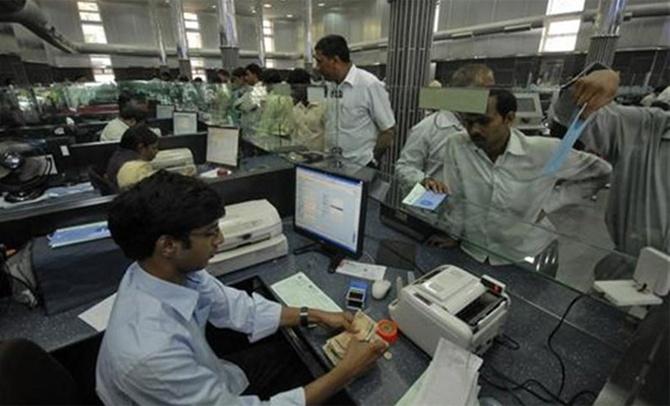The need to allow government shareholding in public sector banks to come down below 51 per cent, says Ashok K Lahiri.

What to do with public sector banks (PSBs), particularly weak ones, is a major concern of recent times.
The Reserve Bank of India (RBI) requires Indian banks to fully conform to the strengthened Basel-III capital ratios by March 31, 2019.
Finance Minister Arun Jaitley, according to the 2016-17 Budget, will continue with the Indradhanush Mission to revamp PSBs.
Mr Jaitley has announced that he will operationalise the Bank Board Bureau soon, strengthen the Debt Recovery Tribunal, amend the SARFAESI Act, and provide Rs 25,000 crore for recapitalisation in 2016-17.
Indradhanush has seven elements: appointments, a bank board bureau, capitalisation, de-stressing, empowerment, accountability framework, and governance reforms. All seven are important. Capitalisation is the one with considerable and direct budgetary implications.
Non-performing assets (NPA), or credits that do not generate cash-flow to the extent and in the period originally envisaged, have more than eroded the net-worth of many PSBs.
The NPAs of 24 listed PSBs and the State Bank of India (SBI) group was almost Rs 4 lakh crore at end-December 2015.
Provisioning for NPAs has destroyed profits. With investor confidence shaken, some PSB share prices have been battered by as much as 50 per cent.
The government has capitalised PSBs in the past. From 1984-85 until 1998-99, almost annually, the nationalised banks were recapitalised, with the total adding up to Rs 20,466 crore.
Furthermore, Rs 6,334 crore of government equity was written off against the accumulated losses of some PSBs.
The problem of capital adequacy for PSBs is not new in India. The problem of NPAs and inadequate capital for PSBs arose in the early-1990s with the introduction of a new regulatory regime with prudential norms and capital adequacy standards.
The standards were on the lines of the 1988 Basel Accord. On March 31, 1992, PSBs had as much as 14.5 per cent of outstanding advances or 6.7 per cent of total assets as NPAs by the extant not-so-stringent classification system.
With the two Bank Nationalisation Acts of 1970 and 1980, the paid-up capital of nationalised banks could be raised either by transfer from the Reserve Fund or by contribution by the central government.
The entire paid-up capital in nationalised banks was held by the government until 1994.
In 1994, with banks experiencing an immediate need for additional capital, the Nationalisation Act was amended to allow the PSBs to access the market. Public shareholding in PSBs was and is required to be a minimum of 51 per cent.
RBI introduced Basel-I norms in 1992. The banks had to attain eight per cent capital to risk-weighted assets ratio (CRAR) specified by the RBI by 1996.
Of the Rs 20,466 crore injected in PSBs during 1984-85 to 1998-99, Rs 10,987 crore were in all PSBs during the two years of 1993-94 and 1994-95 to meet the Basel-I norms. After 1994-95, the infusion was in selected weak PSBs.
There is a palpable need for infusion of capital into many PSBs to meet the current capital-adequacy standards, and to gear up for the enhanced Basel-III standards.
Without such infusion, either there has to be a retrograde policy of RBI forbearance, or a politically hard decision to close down some troubled PSBs. Closing down can be phased by introducing the "narrow banking" model.
A narrow bank would be allowed to invest fresh inflows only in government securities and restricted in its growth of liabilities.
In 1998, for weak banks with inadequate capital, former deputy governor S S Tarapore argued against any infusion, which was tantamount to bail-outs, and for adopting the narrow banking model for weak banks.
In the event, the concept did not find favour.
In the current conjuncture, the government has two options - to provide capital to PSBs from its own funds or allow PSBs to go the market.
Of course, as before, funds can be provided through non-marketable special securities or recapitalisation bonds to make it cashless at the outset.
Accessing the market has two impediments: the current depressed state of the equity market, and the statutory limitation of government holding not falling below 51 per cent.
On March 31, 2014, except for the wholly-owned Bharatiya Mahila Bank, the government's shareholding in PSBs varied from 56.26 per cent in the Bank of Baroda to 88.63 per cent in the Central Bank of India.
With its shareholding below 60 per cent in as many as nine PSBs, including the State Bank of India, the scope for deep dilution of government's ownership in many PSBs is limited by existing laws.
The initiative in the Budget is on the right lines. There is need to amend the relevant acts to allow government's stake in PSBs to come down below 51 per cent to 33 per cent, if not less.
In the meantime, there is no alternative to providing the relevant PSBs with recapitalisation bonds in a phased manner while continuing recovery of impaired loans with renewed vigour.
In this context, one idea that has been mooted is for RBI to recapitalise PSBs. Just as the government can sell off assets that it no longer wants to hold and use the proceeds to make additional investments in PSBs, why does the RBI not do the same?
There are two problems with the idea. First, it was only in June 2007 that the SBI Amendment Ordinance was issued for the RBI to transfer its 59.7 per cent stake in SBI to the government and concentrate on its core central banking role.
There is no good reason to go back to RBI acquiring stakes in the PSBs it regulates.
Second, what assets will RBI sell? The two major assets on RBI's balance sheet are foreign currency assets (Rs 23 lakh crore) and government securities (Rs 6 lakh crore).
Will RBI deplete foreign reserves or do an open market sale of government securities and increase the yield on such securities to recapitalise PSBs? Neither seems reasonable.
The only rationale behind the RBI getting into capitalising PSBs appears to be cosmetic, namely protecting the fiscal deficit in PSB capitalisation process. Not such a good idea.
The writer is an economist.








 © 2025
© 2025